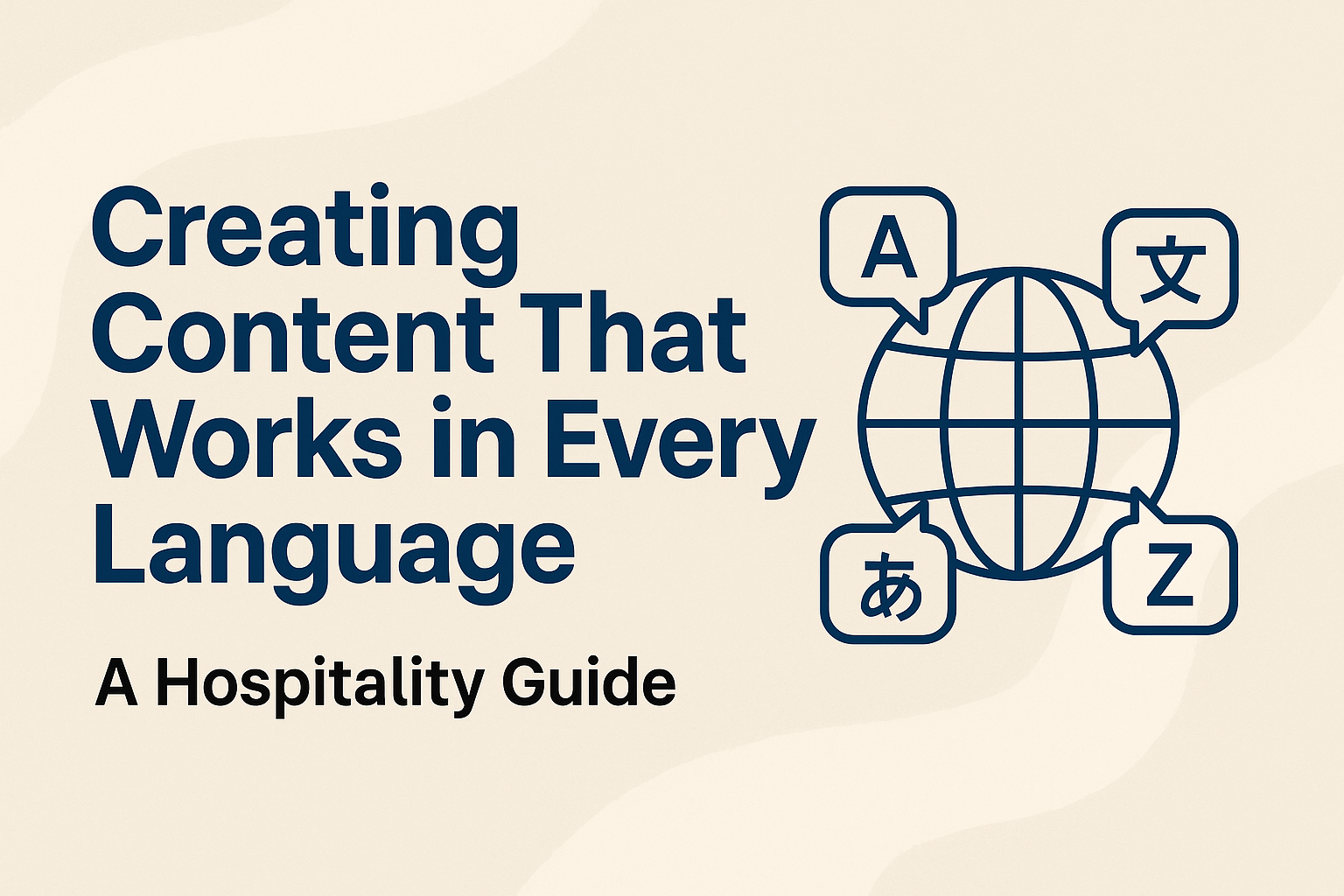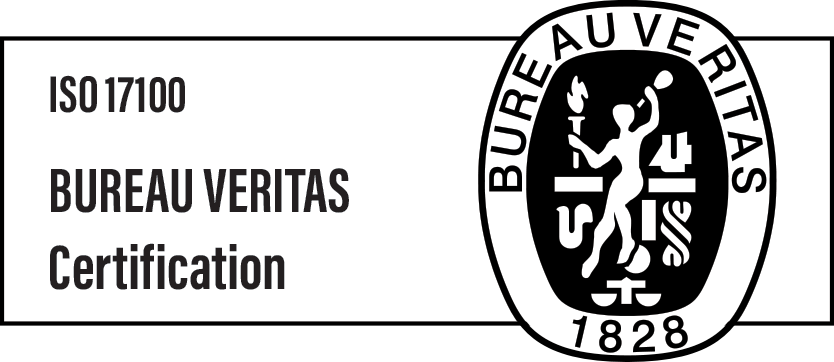Creating content that works in every language

Hospitality is a global conversation
Today’s hotel guests come from all corners of the world. Whether they’re booking a five-star resort in the Maldives or a boutique hotel in Prague, travelers want to feel welcomed and understood—before they even arrive. That starts with your content.
But creating great hospitality content is more than writing catchy slogans or sleek web copy. It’s about telling a story that feels familiar no matter the language. Your brand voice should be clear in English, but it also needs to carry the same warmth, tone, and clarity when it’s adapted for German, Spanish, Japanese, or Arabic. That’s where thoughtful content design comes in.
Rather than focusing solely on translation after the fact, the most successful hospitality brands build content that is ready for the world from the very beginning. They create stories that work across markets, visuals that align with different cultural expectations, and messaging that doesn’t rely on local idioms or puns to be effective.
This guide is for hotel and restaurant brands who want to work smarter with their LSP partners. You’ll learn how to write original content that’s built for adaptation. It’s about being global from the start—not just translating later. And when you approach content this way, your brand voice becomes one your guests will recognize and trust, wherever they are.

Build a brand that travels well
1. Build a brand that travels well
Before writing your next email campaign or updating your website, take a step back and look at the foundation: your brand identity. A clear and consistent identity makes localization much easier. It also helps LSPs understand how your brand should “feel” in another language—not just what it should say.
Start with the basics. Your logo, color palette, and fonts should be flexible enough to work in multiple markets. For instance, overly ornate typography may not be legible when paired with non-Latin scripts. And color choices should be checked for cultural sensitivity—red means luxury in some markets but can signal danger in others.
Next, focus on your brand’s tone of voice. Is it warm and conversational? Bold and confident? Minimalist and refined? Whatever it is, define it clearly and document it well. This helps language partners carry your tone into every translation. A good brand guide includes examples of on-brand writing and clear “dos and don’ts.” Avoid slang or region-specific humor that can lose meaning across cultures.
Finally, think about your storytelling approach. Content rooted in universal human experiences—comfort, discovery, relaxation—will always be easier to localize than content tied to specific cultural references. Instead of “escape the daily grind,” say “unwind in a peaceful setting.” These choices may seem small, but they build a brand that is easier to adapt and more likely to resonate around the world.

Write content with adaptation in mind
2.Write content with adaptation in mind
Once your brand identity is in place, the next step is to write content that is “localization-ready.” That means creating original copy that can be easily adapted without losing meaning, rhythm, or emotional impact.
Start by keeping your language simple and direct. Use short, clear sentences. Avoid idioms, wordplay, or expressions that may not translate well. Instead of saying “the icing on the cake,” say “an added bonus.” Clearer language not only improves localization—it also performs better for non-native English speakers browsing your content before it’s even translated.
Structure your content with flexibility in mind. Leave room for text expansion, especially in digital formats. German and French, for example, often require more words than English to express the same idea. Avoid squeezing copy into tight spaces like buttons or banners. Make sure call-to-action phrases are easy to adapt. “Book now” or “Plan your stay” works better than quirky phrases like “Snag your dream suite.”
It’s also important to work closely with your LSP early in the process. Share outlines or drafts before finalizing content. Ask for feedback on how your phrasing might be adapted. A good language partner can highlight areas that may create friction down the line and suggest more flexible alternatives.
By writing with adaptation in mind, you’re not simplifying your brand—you’re strengthening it. You’re creating messages that connect in more places, with more people, more effectively.

Adapt across channels without losing your voice
3. Adapt across channels without losing your voice
Not all content lives in the same format, and your approach shouldn’t either. A caption on Instagram, an email subject line, and a website booking button all have different constraints. To create content that works in multiple languages, your original copy must be flexible enough to meet each platform’s needs while maintaining your brand voice.
Let’s start with your website. Navigation labels, calls to action, and room descriptions must all be clear and concise—but also engaging. Write headlines that are straightforward yet inviting. For instance, “Explore Our Rooftop Views” is more adaptable than “Catch a Glimpse of City Magic.” The former translates well without losing meaning. The latter depends on cultural context that might not exist elsewhere.
In emails, especially those used for confirmations or offers, clarity is essential. Subject lines should avoid wordplay and keep character limits in mind. “Your Stay is Confirmed” is better than “You’re All Set!” because it’s clear and adaptable. Inside the email, write in logical segments: greeting, message, action. This helps LSPs segment and localize content without breaking flow.
Social media adds another layer of complexity. Captions must resonate quickly and often include emojis or hashtags. Keep the messaging simple, and create a style guide that includes tone rules and content types. Be mindful that what’s lighthearted or humorous in one market may feel off-brand in another.
By writing platform-aware content, you enable your LSPs to do their job more effectively. They’re not forced to rewrite or reinterpret, just adapt. And your voice—consistent, clear, and confident—remains intact across every channel.

Collaborate early for smoother localization
4. Collaborate early for smoother localization
Content that adapts well doesn’t happen by accident. It’s the result of clear communication between your brand team and your language partners. When localization is treated as an afterthought, even strong messaging can fall flat. But when LSPs are brought in early, content becomes stronger, faster, and more globally effective.
Start by involving your LSP during content planning—not just after everything is written. Share your brand guidelines, marketing calendar, and campaign goals. This helps localization teams understand the bigger picture and anticipate any cultural or linguistic hurdles early on.
Establish clear review steps. Instead of sending finalized content with tight deadlines, allow space for linguistic feedback. A language specialist can flag culturally sensitive references or highlight phrases that won’t localize well. They may also suggest alternatives that retain the same tone but work better in the target language.
Build a glossary of key terms and phrases, especially those tied to your brand’s identity—like signature amenities, room names, or slogan lines. Align on how these will be translated or retained across languages. Consistency here builds credibility and avoids confusing your audience.
Lastly, be open to adaptation—not just translation. Sometimes the best result is not a word-for-word copy but a reimagined version that delivers the same emotional impact in a different way. Trust your LSP’s cultural insight. With early collaboration, you gain not only language support but also strategic guidance that shapes better global content.

Welcome every guest with the right words
Welcome every guest with the right words
In hospitality, how you speak to your guests matters just as much as what you offer them. Whether you run a resort, a boutique inn, or a fast-growing hotel chain, your message is part of the experience. When that message is clear, consistent, and culturally aware, it becomes more than marketing—it becomes part of the welcome.
Creating adaptable content is a team effort. It starts with strong brand foundations, clear and flexible writing, and early alignment with your LSP. When these elements come together, your voice doesn’t just cross borders—it builds trust and loyalty in every market.
This isn’t about diluting your brand. It’s about strengthening it in every language your guests speak. When you invest in content that travels well, you’re not just telling your story—you’re inviting the world to be part of it.

